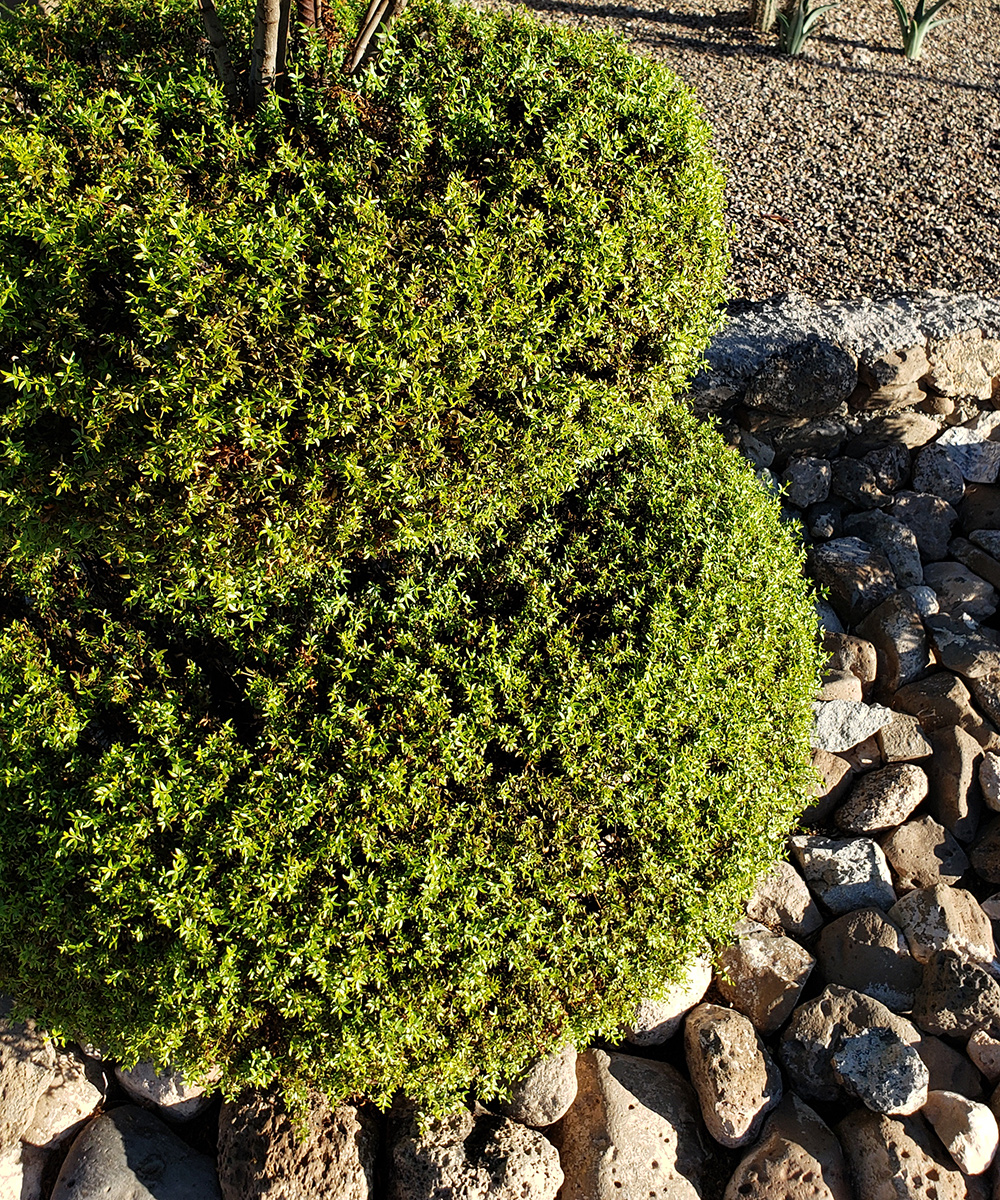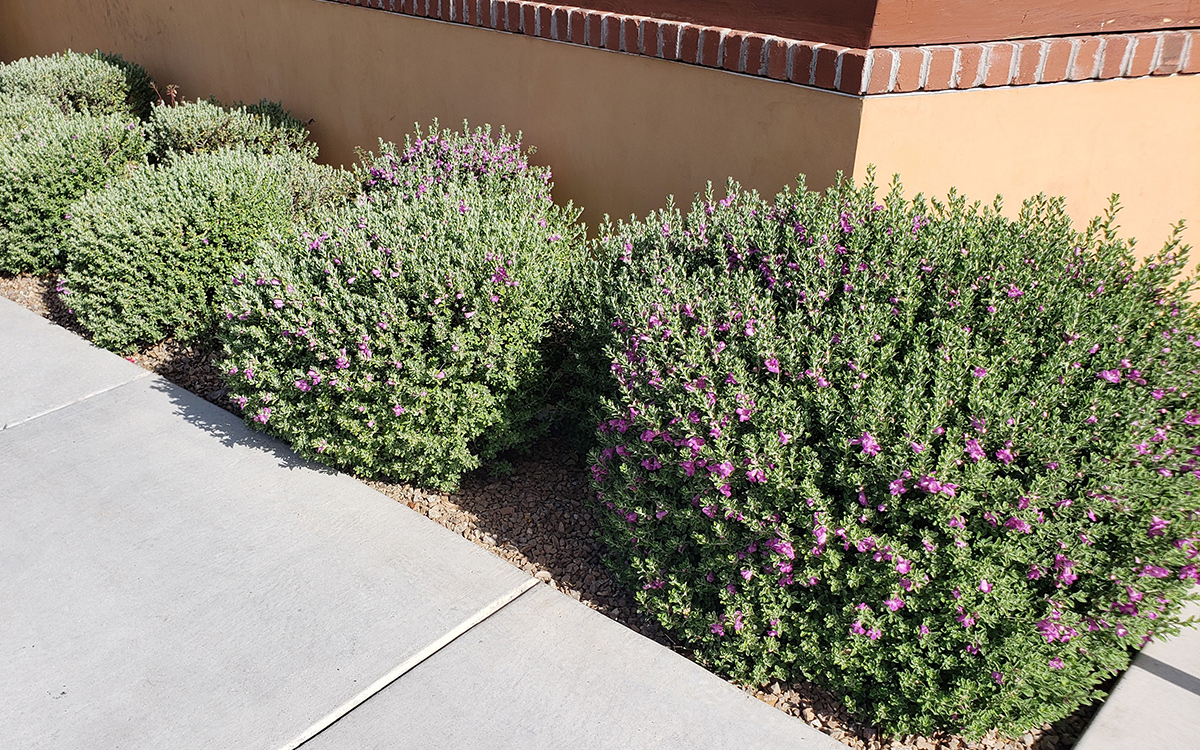
I love the natural shapes of plants in landscape design, but garden style is subjective, and it’s fair to say that gardens should be fun and expressive. We all have our own ideal “look” in mind when we envision a garden space, and who’s to say one is better than another? Some of us are collectors of anything new or unusual. Others seek a bit of nostalgia or want to seamlessly blend into their wild surroundings. Some like their plants well behaved and formal, expressing geometry and order not always found in nature. If the latter category describes you, you may find formality to be more of a challenge in the arid Southwest. There are some arid native plants that work well in formal garden design, however.
What plants can you use in formal gardens in the Southwest?
Traditional plants used in formal design, such as boxwoods (Buxus spp. and cvs., Zones 5–9), beeches (Fagus spp. and cvs., Zones 3–9), and yews (Taxus spp. and cvs., Zones 4–8), are hardly sustainable in desert regions without excessive water use and soil modification. Some regionally adapted plants lend themselves readily to formal use, like smaller grasses or slender conifers. With others, a successful outcome does take some skill. Well-pruned plants need deliberate renewal and careful training, not just a crew cut once a year.
For those looking to cultivate a formal design, considering some of our sustainable southwestern natives is a good place to start. Many are more forgiving and adaptable to formal pruning than we give them credit for. The following native plants are some options that may surprise you. Some of these photos show the highly pruned form of the plant, but perhaps not the most creative use, so that’s for you to decide how far you’d like to go with pruning. After all, it’s your garden!

Curl-leaf mountain mahogany is a great substitute for boxwood
Native to arid slopes from Washington state to Colorado, Arizona, and Baja, curl-leaf mountain mahogany (Cercocarpus ledifolius, Zones 4–10) becomes a large shrub or small tree with intricate branching when left to grow into its natural habit. However, its small sturdy evergreen leaves with curled margins are well adapted to heavy browsing by wildlife—so this native species responds well to heavy manicured pruning as well. It’s a good replacement for boxwood if an evergreen hedge is desired. Little or no irrigation is required by this shrub in most regions.
Fernbush can be sheared and is pollinator friendly
A showy shrub of the Great Basin and Colorado Plateau, fernbush (Chamaebatiaria millefolium, Zones 5–8) thrives in arid conditions and is irresistible to honeybees when its creamy flower spikes emerge in early summer. Also adapted to browsing, it’s easily sheared and shaped, and will renew well if severe pruning is needed.

Creosote bush is a great medium-size, drought-tolerant option for formal pruning
Creosote bush or greasewood (Larrea tridentata, Zones 7–11) is a signature shrub of our southwestern deserts that can be found from central California and Nevada to just south of Albuquerque, on to south Texas and southward nearly to Mexico City. Wild specimens can be among the oldest living plants in the world, reaching thousands of years in age! The closely related Larrea divaricata of Argentina is nearly identical and sometimes considered the same species, giving this species one of the longest north-south ranges in the world. Aside from those curiosities, it’s a durable plant reaching up to 6 feet tall and wide and extremely drought tolerant. Its tiny leaves and fine branching make precise shaping easy, but frequent trimming is needed to maintain detailed shapes. Creosote bush also emits a classic desert scent after watering or rainfall.

Cenizo makes a well-sculpted specimen with vivid pink or purple blooms
Native from south and west Texas and well into Mexico, cenizo, or Texas Ranger shrubs (Leucophyllum spp. and cvs., Zones 7–11), range from 2 to 6 feet tall and wide, with a casual upward spreading or mounding form. The leaves may be bright green or vivid silver, depending on the species. Many cultivars have been selected based on these various qualities. All perform well in arid landscapes and respond well to trimming, so much so that sheared blobs can be overused in commercial settings where they become monotonous gumdrops in street medians and similar locations. However, that shouldn’t diminish the usefulness of a well-sculpted specimen in a private garden. They flower in direct response to warm rains during the monsoon season, transforming into a blaze of pink or vivid purple for weeks at a time.

Baja ruellia has a compact habit that takes well to pruning
A small, rounded shrub from Baja and Sonora, Mexico, Baja ruellia (Ruellia californica var. peninsularis, Zones 9–11) can reach 5 feet tall and wide if allowed. Its flowers are reminiscent of small purple petunias (Petunia cvs., annual). Its compact habit is easily shaped and maintained, and while it is very drought tolerant, it looks and flowers its best with some occasional water.
Even if an abundance of these tightly shaped plants is not for you, you may find a formal accent here or there suits your garden style, much like a well-placed birdbath or colorful container used as a contrasting focal point.
Dan Johnson lives and gardens in Denver and in Tucson, Arizona. He is an associate director of horticulture for the Denver Botanic Gardens.
Photos: Dan Johnson


















Comments
Log in or create an account to post a comment.
Sign up Log in